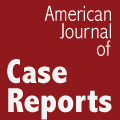Postprandial secretion of serotonin and melatonin in patients with functional dyspepsia
Maria Wiśniewska-Jarosińska, Agnieszka Harasiuk, Ewa Walecka-Kapica, Monika Pawłowicz, Krystyna Stec-Michalska, Jan Chojnacki
Med Sci Tech 2009; 50(3): RA165-168
ID: 881690
Available online:
Published: 2009-03-22
Serotonin and melatonin are secreted in a large amount in the alimentary tract, but the mechanism that drives their secretion is not fully revealed. In healthy people food stimulates the secretion of both hormones, but this mechanism is poorly known in gastrointestinal disorders. Aim: The study aimed at evaluating the role of the meal on serotonin and melatonin secretion in patients with functional dyspepsia. Material and methods: The study was conducted on a group of 20 healthy volunteers (k) and 40 patients with functional dyspepsia at the age of 21-34 years (mean age 26.3 years). According to Rome III Criteria in equal number of patients postprandial distress syndrome (PDS) (20 pts) and epigastric pain syndrome (EPS) (20 pts) were diagnosed. 7 days prior to the evaluation all the studied subjects remained on the same diet and on the day of the study they were recommended the standard liquid diet (Nutridrinks, Nutricia) in the amount of 3 times 400 ml and still isotonic mineral water in the amount of 3 times 500 ml daily. The blood samples were taken in fasting conditions and 2 hours after the meal Serotonin and melatonin concentration in serum were measured applying immunoenzymatic method with the use of IBL antibodies (catalogue number RE 59121 and RE 59021). Results: In the group of healthy subjects an increase of serum serotonin and melatonin concentration after the meals was observed – 160,90 + 31,56 and 181,44 + 27,42 ng/ml (p < 0,05); 8,29 + 2,83 and 8,50 + 2,53 ng/ml (p < 0,01) respectively. In the group of patients with PDS at fasting and postprandial serotonin and melatonin concentrations were 135,81 + 28,76 and 139,72 + 21,77 ng/ml (p > 0,05); 14,14 + 6,28 and 17,06 + 4,79 ng/ml (p < 0,01) adequately. In the group of patients with EPS the results at fasting and after the meal were as follows: 221,49 + 28,4 and 250,64 + 32,04 ng/ml (p < 0,01); 7,79 + 2,51 and 7,67 + 1,80 ng/ml (p > 0,05). Conclusions: Postprandial serotonin and melatonin secretion in patients with functional dyspepsia significantly differs from that in healthy subjects. Differences in postprandial secretion of both hormones can be the cause of varied clinical symptoms in PDS and EPS. (Clin Exp Med Lett 2009; 50(3):165-168)
Keywords: functional dyspepsia, epigastric pain syndrome, postprandial distress syndrome, Serotonin, Melatonin



